Seawanhaka Home
Where Is
Ship's Log
Itinerary
About the Ship
Meet the Skipper
Crew Page
Photo Album
Marine Services
Contact Us
|
|
About Seawanhaka
Facts:
Home Port: Friday Harbor, Washington, USA
Owner: Bill Hanlon
Overall Length: 67 feet
Length on Deck: 58 feet
Builder: Bath Iron Works in Bath, Maine
Designer: Cox and Stevens, New York City
Year Built: 1925
History of Schooner Seawanhaka:
The Schooner Seawanhaka is a 58-foot staysail schooner. She was built at the Bath Iron Works in
Maine in 1925. A total of 16 identical Seawanhaka Schooners were built at that time. Seawanhaka is the only one known to be still sailing. Sister ship Apache has been undergoing a decade-long restoration in San Francisco Bay. We are not sure which hull number Seawanhaka is or who her first owner was (click to see a list of vessels built at Bath Iron Works by hull number – the Seawanhaka Schooners were hull numbers 99 – 114)
The 16 Seawanhaka Schooners were ordered by members of the Seawanhaka-Corinthian Yacht Club of Oyster Harbor, Long Island, NY and the New York Yacht Club. Seawanhaka Yacht Club has a long history - it was founded in 1871, the first yacht club in the Western hemisphere. "Corinthian" was added to the name a few years later. From 1895 until the 1950s, the club sponsored the Seawanhaka International Trophy for Small Yachts, which is the oldest yachting trophy in America. The club also claims that they developed the first spinnaker sails, the first genoas, and the first drainage system on sailboats.
The first owners of the Seawanhaka Schooners were all yachtsmen, mostly from New York, including such famous names as Van S. Merle-Smith and Harold Wesson (i.e. Smith & Wesson) and Irving Cox, the designer of the boats. The designer (Cox and Stevens) is a major architectural firm which has had a long association with Bath Iron Works. The name "Seawanhaka" means "Island of Shells" and comes from the Native American Shinacock tribe that inhabited Long Island, and was their name used for what is now Long Island, New York.
The following text is a copy of an article published in the April 1925 issue of "Yachting Magazine" announcing the Seawanhaka Schooners:
The Seawanhaka One-Design Schooners
We are glad to present herewith the plans of the Seawanhaka Schooner Class, designed by Cox & Stevens for members of the Seawanhaka Corinthian and New York Yacht Clubs. Fifteen of these craft are now building at the Bath Iron Works, and will be the cynosure of all eyes in the races and yacht club runs during the coming season.
The new boats will be 58'6" o.a., 38' w.l., 12' beam, and 7'9" draft. The designers have centered their efforts towards turning out a fair, sweet and well proportioned hull which will be easily driven by a moderate sail plan , and will afford comfortable cruising accommodations. The sheer is graceful, freeboard is ample, and ends are moderately long and well proportioned.
Below decks, a double stateroom aft is separated from the main cabin amidships by a toilet room on the port side and a linen locker and chart racks on the starboard side. Either the stateroom or the main cabin may be made up to accommodate four people when desired. A well equipped galley is forward of the main cabin, and the forecastle is fitted with bunks, lockers, toilet, etc., for a crew of two men.
All the boats will have a knockabout schooner rig with Marconi mainsails. Some will also have Marconi foresails, as shown on the plans, while others, it is said, will have gaff-headed foresails of different design, thus giving an excellent opportunity of trying out the merits of the different rigs. The total sail area is restricted to 1400 sq. ft.
While designed principally for sailing, a small auxiliary motor of about 12 h.p. will be installed, turning a feathering propeller, which will detract very little from their sailing qualities, but which will be thoroughly appreciated when baffling calms are met with. Some of the boats have a Scripps F4 engine, while the others will have a 10-12 h.p. Kermath. |
| 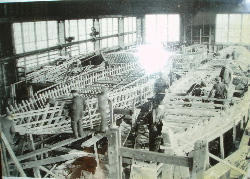
The Seawanhaka Schooners are framed by boat carpenters at the Bath Iron Works.
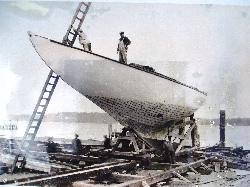
A Seawanhaka Schooner's hull receives its coats of paint in the boat yard of Bath Iron Works.
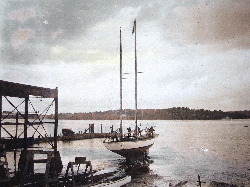
Launching photo of a Seawanhaka Schooner.

A Seawanhaka Schooner sails through the bay (notice the Bath Iron Works building in the background).
|
Schooner Seawanhaka Today:
| Our Seawanhaka schooner has gone through a lot of changes and remodels since she first braved the Atlantic waters in 1925. When Captain Bill bought the schooner from a couple in Anacortes, Washington on his birthday in 1995, the boat had no name. After a little research about the boat, Bill named her SEAWANHAKA in honor of her rich maritime history. He has sailed her through the San Juans, Alaska, Canada, the Northwestern United States, California, Mexico, Central America, South America, French Polynesia, Hawaii, the Samoas, Tonga, Fiji and New Zealand. Seawanhaka has also been hauled out several times, most recently in Suva, Fiji Islands.
Throughout all of these adventures, Seawanhaka has remained a faithful vessel. She offers cozy lodgings for 4-5 people, with 2 private cabins and a main salon in addition to the captain's quarters. There are 2 heads (toilets), one with a shower, a fully-equipped galley and a forward v-berth for storage.
The Seawanhaka Schooners were the first schooners designed with a Marconi rig. Although she was originally rigged with a traditional foresail, she was re-rigged as a staysail schooner. The floor plan of the boat is much different than the original plan - a "doghouse" has been added behind the main mast, the galley was moved back next to the main salon and a second head was added up forward. More recently, Bill has improved Seawanhaka with brand-new sails, new rigging, new sail covers, a heater, a stove, refrigeration, and countless other improvements.
| 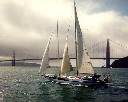
Seawanhaka sails through San Francisco Bay in October 1995.

A view of Seawanhaka's main cabin.

The starboard bunk, one of the two private cabins on Seawanhaka

Seawanhaka racing in the America's Schooner Cup race in San Diego in March 2004.
|
Special thanks to Seth Washburn of the Maine Maritime Museum, the "Bath Iron Works List of Ships" by Mark Cheetham, and "Bath Iron Works: The First Hundred Years" by Ralph Linwood Snow for the information used to compile this webpage. |
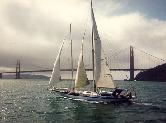 Schooner Seawanhaka
Schooner Seawanhaka![]()